ECB expectations, US strikes and precious metals in China
.png)
This week’s charts begin with futures markets’ take on ECB interest rates: yesterday’s “dovish hike” was probably the last one, and rate cuts will come in the spring. Turning to the tight US labour market, we visualise how few strikes there have been since 1990; as the UAW begins industrial action against the Big Three, times are changing. For China, we have a dashboard showing how futures traders are betting on industrial commodities and precious metals, as well as a visualisation of how property prices used to reliably go up month on month across the country. For Europe, we examine the seasonality in Citigroup’s index of economic surprises and show how French nuclear power is coming to the rescue of the electricity grid after last year’s ill-timed reactor maintenance. Finally, we compare the budget deficit blow-outs in the pandemic to nations’ (generally) much healthier public finances today.
The market’s take on a future ECB pivot
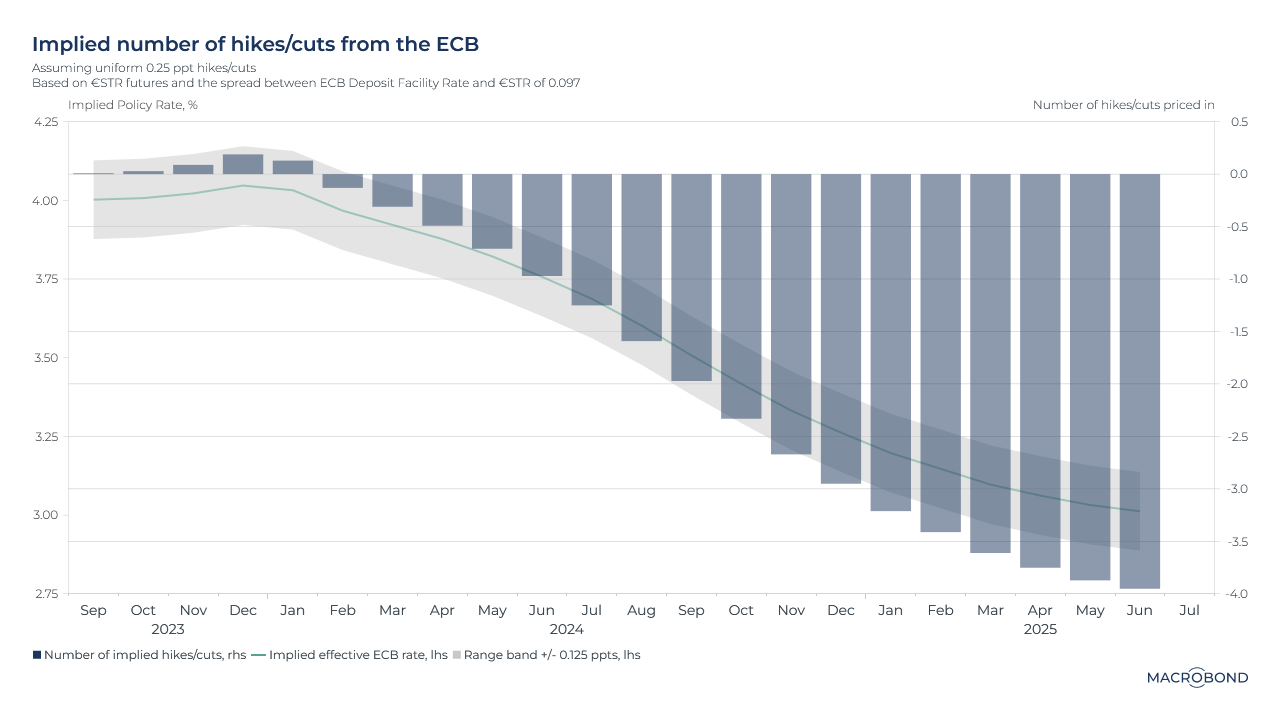
In a split decision, the European Central Bank lifted its key interest rate by a quarter point to 4 percent yesterday, the highest level since the institution was created in the 1990s. The ECB also cut growth projections while lifting inflation forecasts. However, analysts and markets interpreted the ECB’s guidance as suggesting this “dovish hike” is probably the last one, and the euro fell.
To quote the central bank directly: “interest rates have reached levels that, maintained for a sufficiently long duration, will make a substantial contribution to the timely return of inflation to the target.”
What is the futures market telling us today?
This chart looks at euro short-term rate futures as a guide to market expectations for further ECB rate moves. Indeed, there are few bets on another rate hike in the remainder of 2023. And the chart also implies that the central bank will pivot to its first rate cut in the spring.
This chart has moved substantially over the past day. Markets had expected one more hike in 2023, but weren’t sure when it would come. Macrobond users can click through to the chart and toggle the date to see how it looked before the ECB’s meeting.
More American workers are striking
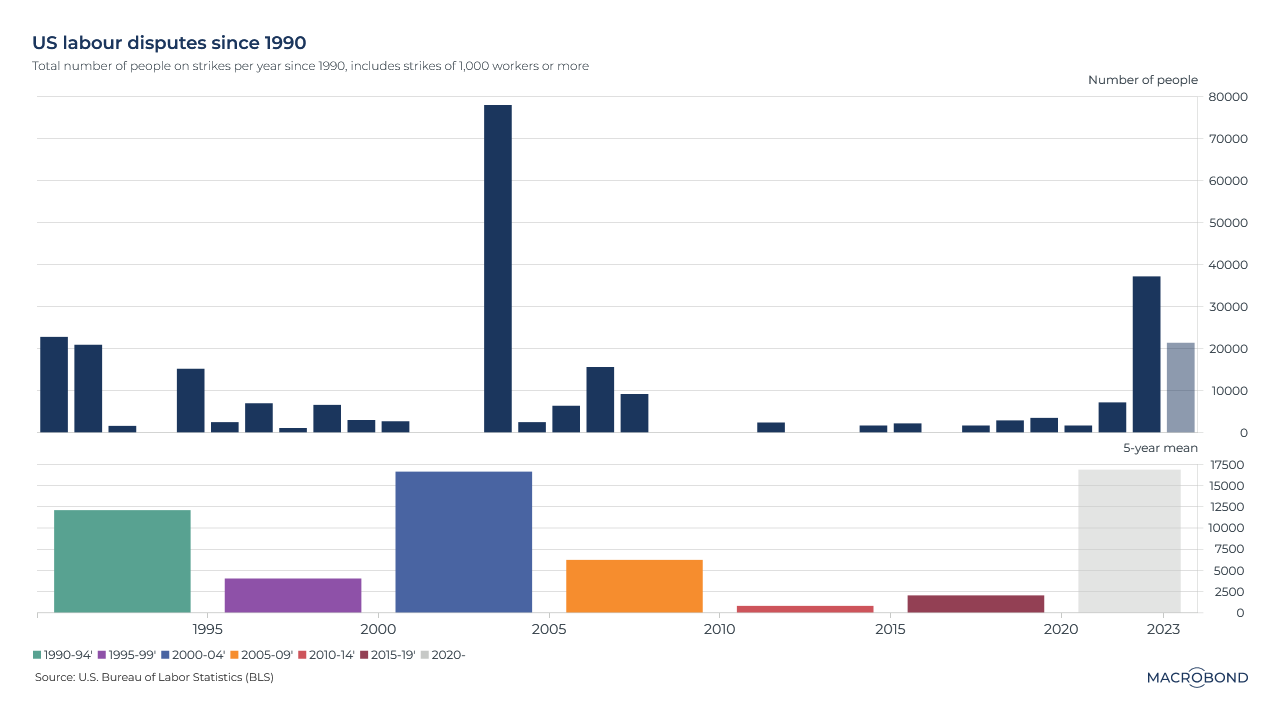
Given the tightness in the US job market, it should be no surprise that there are more labour disputes than there used to be.
For the first time ever, the United Auto Workers are on strike against all of the Big Three car makers at once.. In theory, 145,000 workers could walk off the job, but for now, fewer than 13,000 workers are striking in targeted action against three plants.
This chart measures the total number of people on strike in a given year since 1990. (Only strikes involving more than 1,000 individuals are tracked, and the breaking UAW news overnight is too fresh to be included.) The second pane creates “eras” to compare by calculating five-year averages.
Generally, the post-1990, pre-pandemic period was notable for how few labour disputes occurred. The only year to have more striking workers than 2022 was 2003, when 70,000 supermarket staff walked off the job in Southern California. Will the UAW shatter that recent record?
Shanghai commodities: precious metal bulls, nickel and fuel oil bears
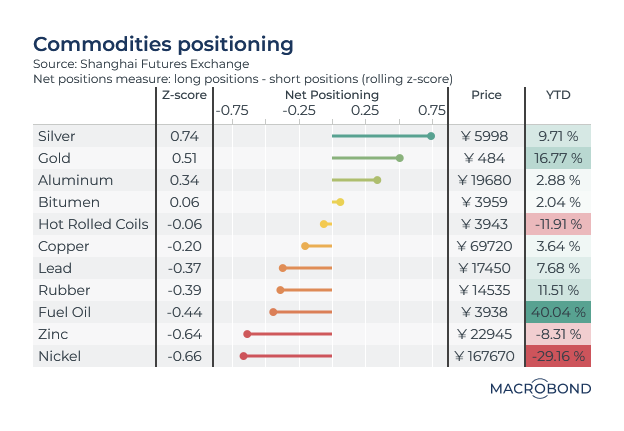
This chart looks at the futures positioning for different commodities on the Shanghai Futures Exchange. Investors who are betting on price increases or declines are netted out to create an overall positive or negative position.
The right-hand columns show the commodities’ price performance in yuan. It’s notable that investors are betting nickel has further to fall after declining more than 25 percent this year, partly due to a disappointing recovery in Chinese demand.
Rubber and fuel oil prices, meanwhile, are up, but futures positions indicate that speculators believe these commodities will unwind their gains.
As for the biggest net long positions, they’re in silver and gold. Notably, the Chinese central bank has been stocking up on bullion throughout 2023. As for silver, it too is a precious metal, but one with more industrial applications, including emerging green-energy technologies.
Seasons for positive or negative economic surprises in the eurozone
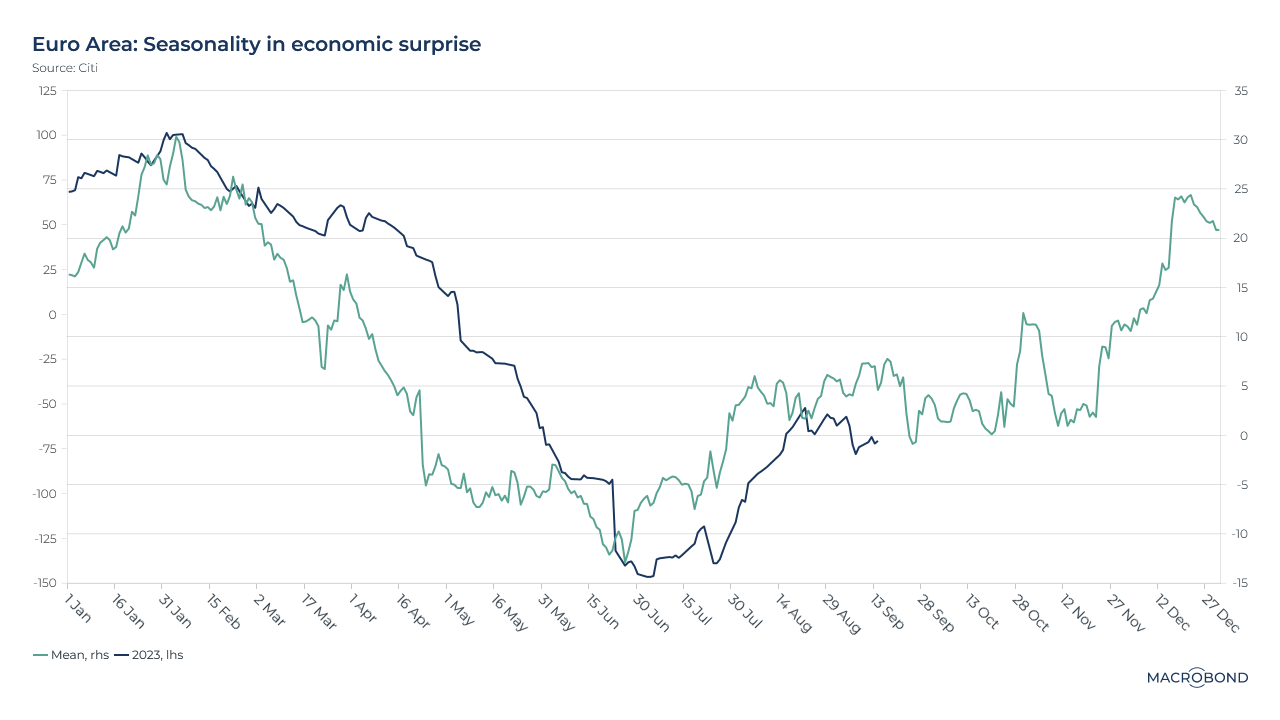
Tip: this chart can be applied to different countries using change region functionality.
This chart tracks the Citigroup Economic Surprise Index – which aims to measure whether economic data is coming in below or above analysts’ expectations.
For the euro area, Citigroup’s methodology suggests there is an interesting seasonality effect: over time, the average shows that indicators tend to beat estimates in the winter and disappoint in the summer.
For the first half of 2023, the eurozone’s Economic Surprise Index was more positive than the historic trend. Since the end of June, reality has been more disappointing than usual.
Peaks and troughs in Chinese housing
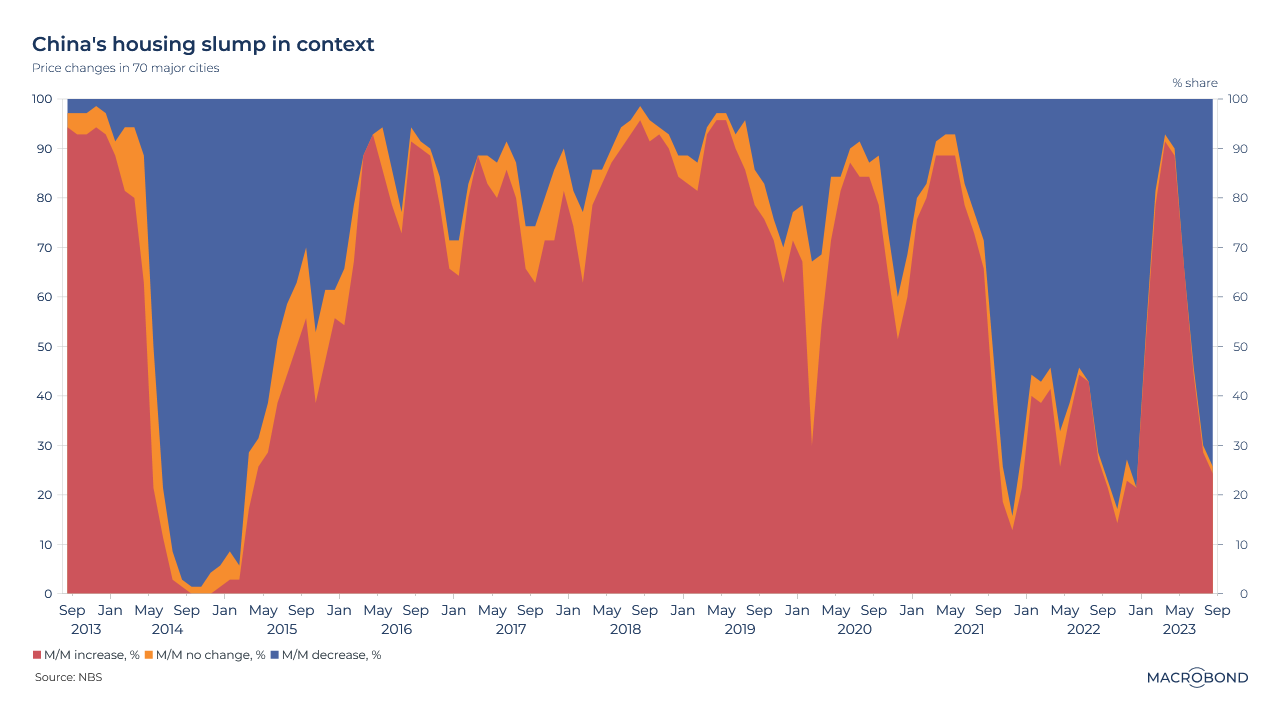
This chart takes a 10-year look at the residential real estate market for 70 major cities in China, giving some context for recent years’ slump and a short-lived rebound in 2023.
Using monthly data, these cities were grouped into three buckets: month-on-month property price increases (red), decreases (blue) or no change (orange).
For most of the past decade, 60 percent or more of China’s big cities were experiencing monthly price increases, as the preponderance of red on the chart shows.
The slump in 2014 is notable, as is the rebound in 2015 after the central bank lowered interest rates.
France’s nuclear plants are back in business in time for winter
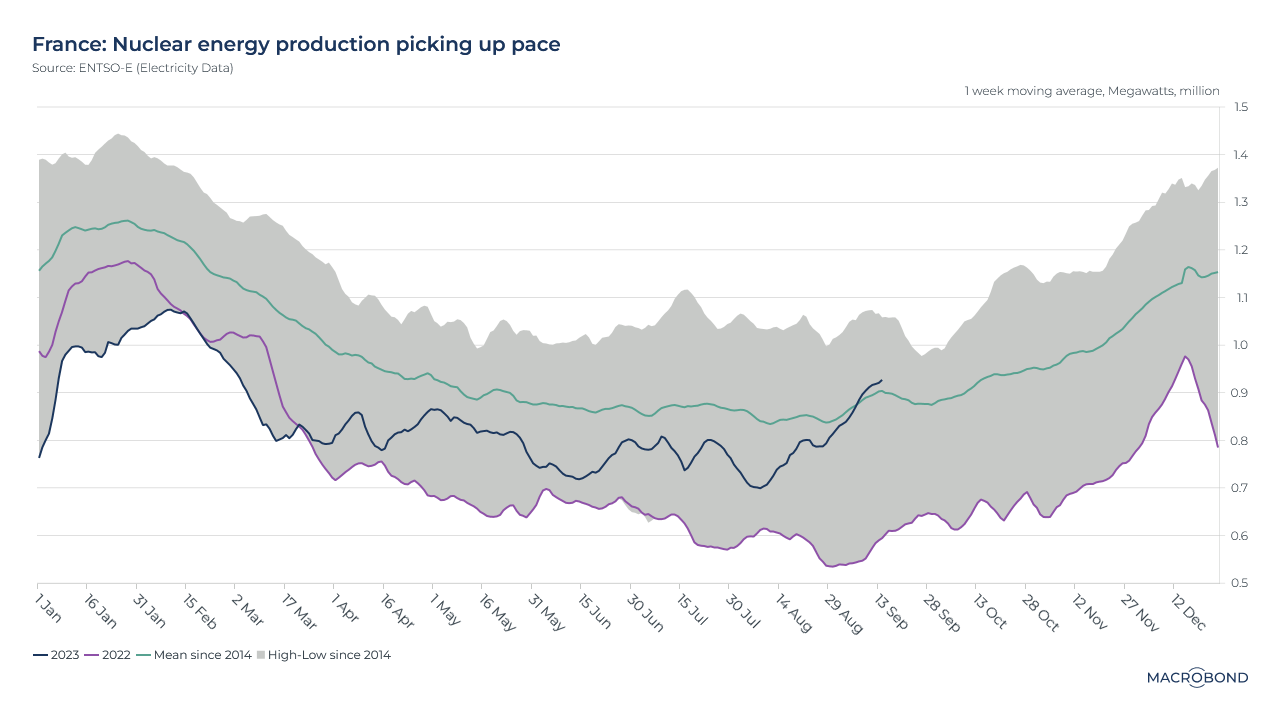
In December, we wrote about France’s ill-timed nuclear power-plant repairs. Maintenance issues required EDF to power down several reactors just as Russia cut gas supplies to western Europe and the Nord Stream pipeline was sabotaged. Electricity prices soared.
This week, we are revisiting that chart of French nuclear power output, and it’s a much happier picture. As the purple line shows, 2022 output set 10-year lows. But the line for 2023 output is in dark blue and has been steadily gaining against the 10-year average – recently surpassing it.
This is a hopeful sign for the European electricity grid as the Russia-Ukraine war grinds on and the continent faces another winter with much less gas from its traditional source. Indeed, France overtook Sweden to become Europe’s top net power exporter recently, while Germany, which recently shut down its last nuclear plants, has moved from power exporter to importer.
Government budget deficits close the Covid chasms
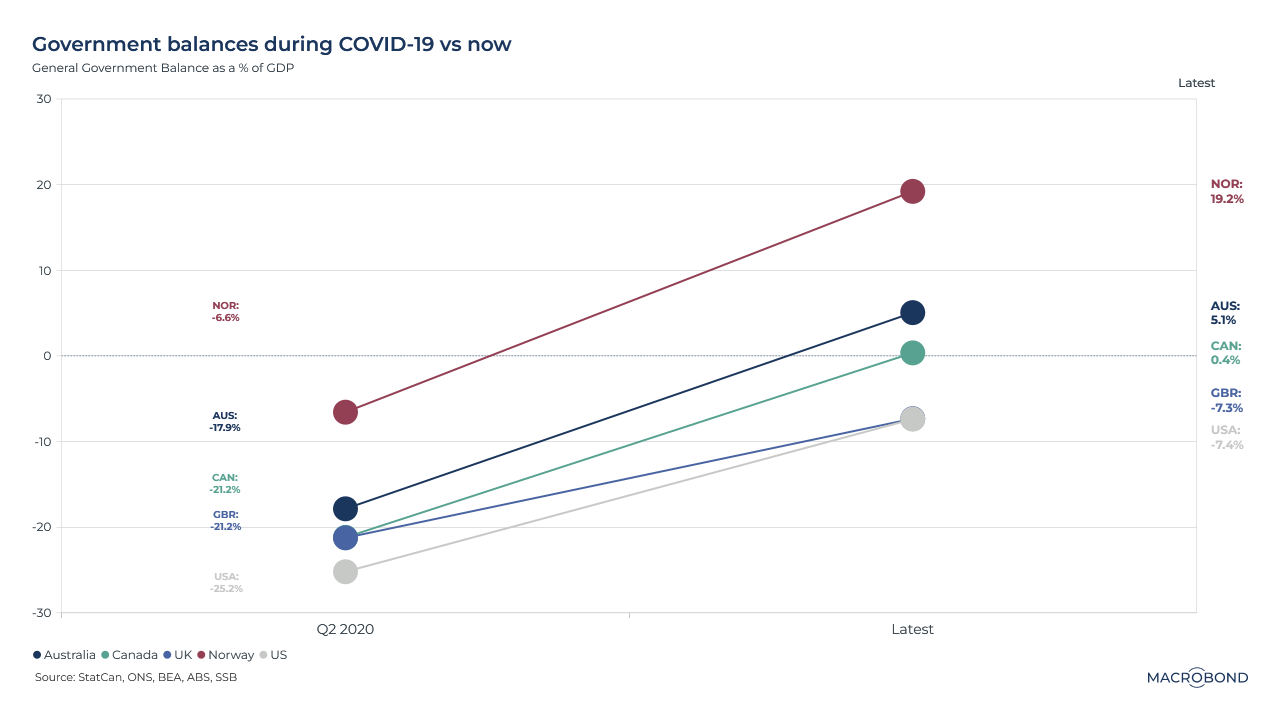
More than three years after the worst of the pandemic, governments are repairing the public finances.
This chart looks at governments’ budget deficits or surpluses as a percentage of GDP. It compares the most recent quarterly figure to the second quarter of 2020, when the pandemic was having its peak fiscal effect: populations were locked down, tax receipts were plummeting as a result, and governments were rolling out emergency support to businesses and workers whose jobs had disappeared overnight.
Norway’s oil wealth makes it a special case on this chart – running the smallest deficit in 2Q 2020 and the biggest surplus today. Australia has been smashing its earlier surplus forecasts amid a robust labour market and healthy commodity prices.
5 topics
.png)
Macrobond delivers the world’s most extensive macroeconomic & financial data alongside the tools and technologies to quickly analyse, visualise and share insights – from a single integrated platform. Our application is a single source of truth for...
Expertise
.png)
Macrobond delivers the world’s most extensive macroeconomic & financial data alongside the tools and technologies to quickly analyse, visualise and share insights – from a single integrated platform. Our application is a single source of truth for...
.png)